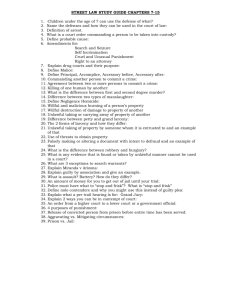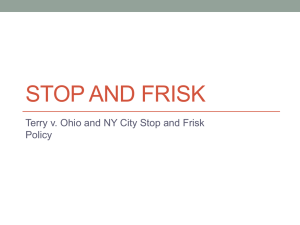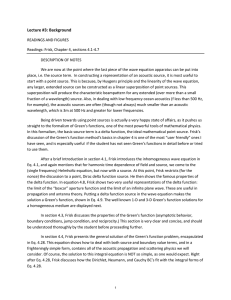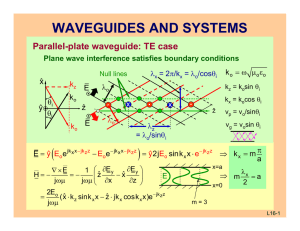Lecture #6: Background
advertisement
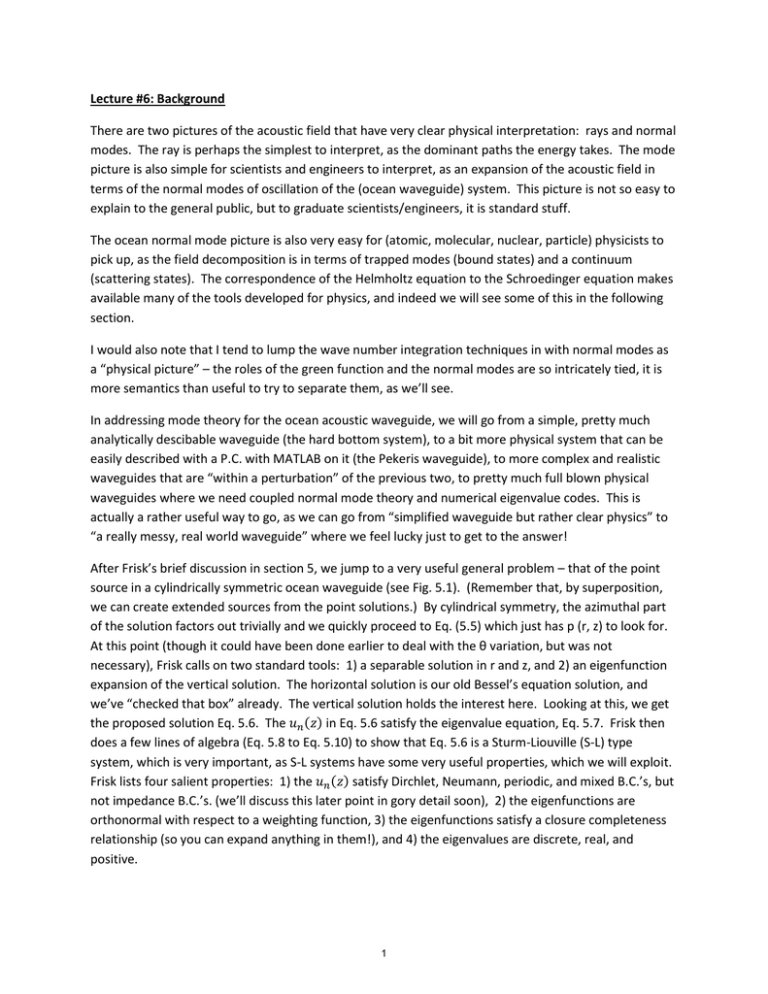
Lecture #6: Background There are two pictures of the acoustic field that have very clear physical interpretation: rays and normal modes. The ray is perhaps the simplest to interpret, as the dominant paths the energy takes. The mode picture is also simple for scientists and engineers to interpret, as an expansion of the acoustic field in terms of the normal modes of oscillation of the (ocean waveguide) system. This picture is not so easy to explain to the general public, but to graduate scientists/engineers, it is standard stuff. The ocean normal mode picture is also very easy for (atomic, molecular, nuclear, particle) physicists to pick up, as the field decomposition is in terms of trapped modes (bound states) and a continuum (scattering states). The correspondence of the Helmholtz equation to the Schroedinger equation makes available many of the tools developed for physics, and indeed we will see some of this in the following section. I would also note that I tend to lump the wave number integration techniques in with normal modes as a “physical picture” – the roles of the green function and the normal modes are so intricately tied, it is more semantics than useful to try to separate them, as we’ll see. In addressing mode theory for the ocean acoustic waveguide, we will go from a simple, pretty much analytically descibable waveguide (the hard bottom system), to a bit more physical system that can be easily described with a P.C. with MATLAB on it (the Pekeris waveguide), to more complex and realistic waveguides that are “within a perturbation” of the previous two, to pretty much full blown physical waveguides where we need coupled normal mode theory and numerical eigenvalue codes. This is actually a rather useful way to go, as we can go from “simplified waveguide but rather clear physics” to “a really messy, real world waveguide” where we feel lucky just to get to the answer! After Frisk’s brief discussion in section 5, we jump to a very useful general problem – that of the point source in a cylindrically symmetric ocean waveguide (see Fig. 5.1). (Remember that, by superposition, we can create extended sources from the point solutions.) By cylindrical symmetry, the azimuthal part of the solution factors out trivially and we quickly proceed to Eq. (5.5) which just has p (r, z) to look for. At this point (though it could have been done earlier to deal with the θ variation, but was not necessary), Frisk calls on two standard tools: 1) a separable solution in r and z, and 2) an eigenfunction expansion of the vertical solution. The horizontal solution is our old Bessel’s equation solution, and we’ve “checked that box” already. The vertical solution holds the interest here. Looking at this, we get the proposed solution Eq. 5.6. The ( ) in Eq. 5.6 satisfy the eigenvalue equation, Eq. 5.7. Frisk then does a few lines of algebra (Eq. 5.8 to Eq. 5.10) to show that Eq. 5.6 is a Sturm-Liouville (S-L) type system, which is very important, as S-L systems have some very useful properties, which we will exploit. Frisk lists four salient properties: 1) the ( ) satisfy Dirchlet, Neumann, periodic, and mixed B.C.’s, but not impedance B.C.’s. (we’ll discuss this later point in gory detail soon), 2) the eigenfunctions are orthonormal with respect to a weighting function, 3) the eigenfunctions satisfy a closure completeness relationship (so you can expand anything in them!), and 4) the eigenvalues are discrete, real, and positive. 1 Given all this goodness, one can now plunk the Eq. 5.6 solution into Eq. 5.5 and after a few lines of algebra, come to Eq. 5.20, which is the “normal mode solution” for the pressure, p(r,z). Eq. 5.22 shows a simple asymptotic form of this. We are now “ready to roll!” In section 5.2.1 of Frisk, we come to the “easy to understand, analytic toy solution” to the waveguide – a very useful thing, and actually not even that horrible a first approximation to reality! Since this system is a one layer, constant density one, the vertical equation Eq. 5.23 is trivial, and the modal solutions Eqs. 5.24-5.26 are easy to write down, and to interpret as interfering up and down going plane waves (Eq. 5.27). Memorizing Eq. 5.24 for the modes and their eigenvalues, and the picture in Fig. 5.3 is a good idea. With these simple forms, you can do a lot! Frisk discusses the nodes of the modes (nice rhyme!) next, and shows how to make modes vanish. (Simple trick, and it really works – no Houdini needed). The next section on modal phase velocity, group velocity, and cutoff frequency are pretty straightforward (and should be at this level), so let me just hit one or two high points. Re the phrase velocity dispersion relation, please remember the difference between geometric and intrinsic dispersion! The former is pure geometry, whereas, the latter depends on the materials the waveguide is composed of! The three regimes of modal propagation are also important: Propagating, standing wave, and evanescent! Also, Eq. (5.3.2) for the number of propagating vertical modes is useful and is simply the number of “half wavelengths” one can stuff in the vertical direction. Finally, there is one cute relationship you can see immediately that Frisk didn’t include: for all modes, all frequencies. You can’t beat the speed limit even in a waveguide! (This has a nice electromagnetic interpretation in terms of not being able to transmit information faster than the “speed of light.”). Frisk’s next section, “Modal intensity, interference wavelength, and cycle distance” should be a separate chapter heading in my mind – it is simple, but very important. One of the most usual measurements in ocean acoustics is p(r,z), from which one quickly processes the intensity, | ( )| . Frisk shows this in modal form in Eq. (5.44). A simple re-write of this equation shows the intensity as being the sum of a constant term (a fixed level) plus interference terms in range! It is this interference pattern in range that we continuously observe and try to model. The interference cycle for two modes is given by Eq. (5.46), another good, simple form to remember. Frisk gives a nice example of a two-mode pattern in this section, see Fig. 5.6. One can also look at an “equivalent ray” picture of the model propagation, as Frisk does in Eq. 5.50-5.56, and shows in Fig. 5.7. At the far end of section 5.2, Frisk throws in a slight warning that all of mode theory may not be a “Sturm-Liouvillian Paradise” by introducing the continuum via a hard bottom waveguide example. By dropping the bottom layer to infinity (not physical, even with global warming sea level rise, but mathematically OK), one goes from discrete modes to continuous ones – not what one expects of a S-L problem! But by using a limiting process, one can use proper S-L solutions to solve seemingly improper S-L problems, as we will see in great detail soon. In Eq. (5.67), Frisk retrieves the (semi-infinite half space) Lloyd mirror result from the discrete mode solutions, a nice example of how this trick can work! 2 In section 5.3, Frisk begins to move on to the next level of waveguide complexity – a pressure release surface over an isovelocity water column over an isovelocity fluid bottom half space (Fig. 5.7). This is the so-called “Pekeris model,” and it is of enormous practical use! In Eqs. 5.68-5.71, and Fig. 5.8, Frisk follows an old Clay and Medwin derivation to get the modal eigenvalue equation for this system in four simple steps! Eq. (5.71) is another “commit to memory” gem, and contains a wealth of physics in a tiny equation. Section 5.4 of Frisk discusses the problem of a lower velocity (than the water) bottom half space, which does not trap modes and thus leads right into the improper S-L, continuum problem. Just read section 5.4.1 – we’ll get to the contuum, in a slightly different way from Frisk, shortly. Section 5.5 jumps into the more usual problem we want to examine – a bottom halfspace with higher soundspeed than the water (see Fig. 5.13). For this waveguide, one has trapped modes for (using grazing angles) and continuum modes (TBD!) for for . Figure 5.14 shows this graphically, and Eq. 5.140 shows the field as the sum of the two contributions. In Section 5.5.1, Frisk tackles the proper modes of the Pekeris waveguide. The arguments to get the ( ) solutions in Eq. (5.146) are easy, and are similar to the hard bottom case. Frisk then discusses the modal depth eigenfunctions and their nodes, and their differences from the hard bottom case. A nice depiction of the Pekeris trapped modes is given in Fig. 5.15. The modal cutoff frequency is described next, with the difference from the hard bottom coming from the bottom having finite sound speed. The modal phase and group velocities for the trapped modes are a bit more interesting than the hard bottom case. (Contrast Fig. 5.16 with Fig. 5.5). For the phase velocity, Cwater < C < Cbottom. The group velocity is even more interesting, going from Cbott near modal cutoff frequency (the “ground wave”) to a minimum with V< Cwater (the “Airy phase”) to Cwater at high frequencies (the “water wave”). Frisk gives long, but very useful, analytical forms for and , which can be used to check more complex computer codes. The modal intensity, interference wavelength, and cycle distance section also should be a “stand alone” given the meat in it. Again, the equivalent ray analogy is used (see Fig. 5.17), but the finite speed bottom introduces a twist! Due to the extra reflection coefficient phase term in the eigenvalue equation (Eq. 5.17), each of the trapped modes gets a lateral shift (called “beam displacement”) upon reflecting from the bottom! This is a real, measureable effect, and is treated simply and elegantly in Frisks section. 3 MIT OpenCourseWare http://ocw.mit.edu 2.682 Acoustical Oceanography Spring 2012 For information about citing these materials or our Terms of Use, visit: http://ocw.mit.edu/terms.



